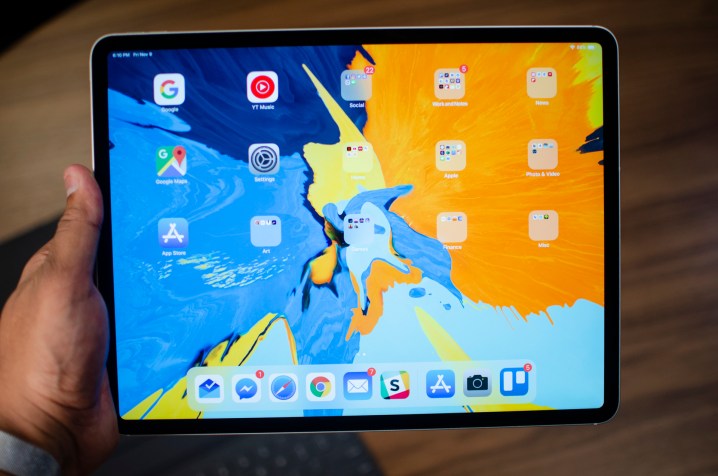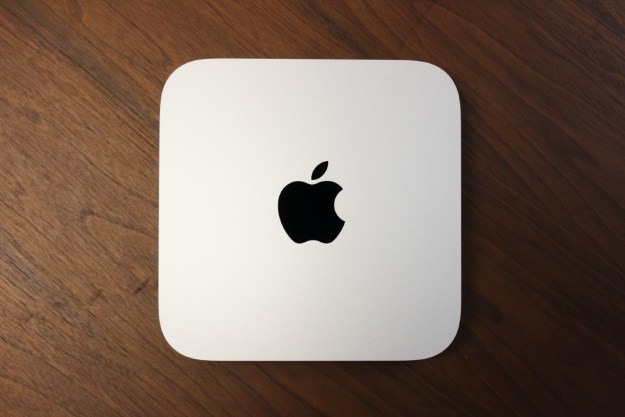After months of speculation and predictions, the new iPad Pros are finally here, and it’s time once again to compare them to Apple’s M1 MacBook Air. The new M1 chip blows the competition out of the water. The Air has an impressive battery life, and its fanless design makes it totally silent.
And thanks to Big Sur’s new design language and the M1 chip’s ability to run iPhone apps on MacOS, the MacBook Air is more like the iPad Pro than ever before. On the flip side, the new iPad Pros will come with the same M1 chip found in the MacBook Air and Apple’s other recent Mac products. That means the iPad Pro is more like a computer than ever.
With so much in common, which one will come out on top?
Display and design

Ever since its redesign in 2018, the MacBook Air has only been available in a 13-inch size. That’s no different with Apple’s M1 MacBook Air, which uses the same exterior chassis as the previous model. It’s got the same 2,560 x 1,600 resolution (227 ppi), the same 16:10 aspect ratio, and the same thin (but not ultra-slim) bezels. Its Retina display also features True Tone, which dynamically adjusts the white balance to match the ambient light.
The iPad Pro’s display is a little different. There are two sizes of iPad Pro to choose from — 11 inches and 12.9 inches — with the former having a 2,388 x 1,668 resolution and the latter coming with a 2,732 x 2,048 resolution. The 11-inch iPad Pro has a 264 ppi pixel density, which should make it a little sharper than the MacBook Air, despite having similar screen sizes.
Both the 11-inch and 12.9-inch iPad Pros come with True Tone and have an edge in that their dynamic refresh rate goes all the way up to 120Hz, giving them beautifully smooth scrolling and animations. The MacBook Air is still locked at 60Hz.
The 12.9-inch iPad Pro comes with Apple’s new Liquid Retina XDR display. It’s a mouthful, but the new display has some promising features. Along with its high refresh rate, it also has 10,000 mini-LEDs in the panel. That allows the screen to have 2,500 dimming zones, giving it an impressive 1,000,000:1 contrast ratio and nuanced HDR. Apple says it’s on par with the Pro Display XDR, but that remains to be seen. It should be impressive, though.

Both the MacBook Air and the iPad Pro now come with Magic Keyboards. In both cases, that’s a vast improvement over what was on offer before. Previous models of the MacBook Air were stuck with the shallow, failure-prone butterfly keyboard, while the keys on the iPad Pro’s keyboard case were soft, mushy, and unsatisfying. For both devices, this is a major upgrade.
The Magic Keyboard is very different from both previous keyboard designs. As we said in our MacBook Pro 16 review, it’s “the best Mac keyboard ever released,” with large keys, a snappy mechanism, and even a physical Esc key. We love it.
Performance

Let’s talk about the MacBook Air first. The M1 MacBook Air makes a monstrous leap in performance. The previous MacBook Air from earlier this year was stuck with just two cores and four threads in the base model. The M1 MacBook Air has an eight-core CPU, a seven-core GPU, and Apple’s 16-core neural engine.
How does that translate to performance? Not only does the M1 MacBook Air beat out the previous model, but it also essentially beats out most other mobile processors, especially in single-threaded performance. That means if you’re a budding content creator or photographer, the MacBook Air is finally a viable option for complex tasks.
The 2021 iPad Pros will come with the M1 chip, the same found in the MacBook Air. Apple is promising a 50% increase in performance, which is a really impressive generational leap. That means editing photos and video, playing graphics-intense games, and even multitasking will be more fluid than ever.
However, there is one question that begs to be asked. Performance on the last iPad Pro was great as well. In fact, there wasn’t really any single app that pushed the iPad Pro to its limit. It was already the fastest tablet on the market, and the M1 processor will make it even more so. But is there any reason it needs to be faster?
Part of what limits the capability of the iPad Pro is iPadOS itself. Maybe we will see some exciting overhauls at WWDC in June to justify the inclusion of the M1.
Portability

Both devices are designed for portability. The MacBook Air is Apple’s thinnest and lightest laptop, while the iPad Pro’s tablet status makes it easy to put in a bag and take wherever you go. The MacBook Air weighs in at 2.8 pounds and measures 11.97 x 8.36 x 0.63 inches. Its all-aluminum construction keeps it lightweight while still making it strong and sturdy, as you’d expect from an Apple laptop.
The 12.9-inch iPad Pro is the closest model to the MacBook Air in terms of size. Its Wi-Fi model weighs 1.41 pounds, while the Wi-Fi and cellular version comes in at 1.42 pounds — half the weight of the MacBook Air. It measures 11.04 x 8.46 x 0.23 inches, putting its dimensions close to those of the MacBook Air.
The 11-inch model is a fair amount more portable, though, weighing just 1.04 pounds and measuring 9.74 x 7.02 x 0.23 inches. It’s the one to go for if small size is important to you.
Apple claims the MacBook Air’s battery will last for up to 15 hours of wireless web browsing, up to 18 hours of Apple TV playback, and up to 30 days of standby time thanks to its built-in 49.9-watt-hour battery.
The iPad Pro doesn’t last quite as long, but it’s not far behind. Apple says both models can give you up to 10 hours of Wi-Fi web browsing and video playback, or nine hours of web browsing using a cellular network. The 11-inch model has a 28.65-watt-hour battery compared to the 12.9-inch model’s 40.88-watt-hour battery.
The app ecosystems

Big Sur and the introduction of the M1 chip mark the largest integration of MacOS and iOS’s app stores since Mac Catalyst. Catalyst allowed developers to easily port their iPad apps to Mac.
With Big Sur and M1, many iPhone and iPad apps now run natively in MacOS. However, the experience is mixed, to say the least. The MacBook Air doesn’t have a touchscreen, so Apple has implemented touchpad controls, which are confusing at best and frustrating at worst. Developers also have to opt in to allow their apps to appear on Mac, and users will notice many of their favorite iPhone or iPad apps missing because the developers decided not to do it.
So, while there is certainly progress being made, there is still a solid divide between the two app ecosystems.
Configurations and price

The MacBook Air’s configurations aren’t as robust as they were last time around, but with the M1 chip being the only option, that is to be expected. The base model of the M1 MacBook Air includes the M1 chip, 8GB of unified memory, and a 256GB SSD. Users can configure the 8GB model with 512GB, 1TB, and 2TB SSDs as alternatives. You can also upgrade to 16GB of RAM, with the base model of that starting with a 512GB SSD. That can be upgraded to 1TB or 2TB.
For I/O, users are just as limited as they have been in the past. You get two USB-C ports, the Magic Keyboard, the Force Touch trackpad, and a Touch ID sensor. The MacBook Air also supports Wi-Fi 6 and Bluetooth 5.0. The webcam is the same dismal 720p resolution we’ve all grown accustomed to.
The configurations are even less flexible on the iPad Pro, where users only determine the internal storage (though
If you prefer the 12-inch version, the entry-level model starts at $1,099, while the top-end model costs $2,299. That puts the price premium for shifting up from 11 inches to 12.9 inches at $200.
That’s a sizable price jump from last year, but keep in mind the 12.9-inch does come with an improved display and both come with
What about that snazzy new Magic Keyboard cover for the iPad Pro? It’ll give you a device that’s even more closely comparable to the MacBook Air, but be warned — it’s extremely expensive. The 11-inch version costs a princely $299, while the larger edition is an eye-watering $349. Even with the 11-inch iPad Pro, you’re looking at paying a minimum of $1,098 for the combination, which is $99 more than the entry-level MacBook Air.
The MacBook Air’s power makes it the clear winner

We still think the MacBook Air is the best option for most people. While having the M1 in the new iPad Pros is exciting, we can’t recommend it for everyone until we see how iPadOS changes with the new chip. And while the Liquid Retina XDR display seems awesome, at $1,099 it may not be necessary for most people.
The MacBook Air isn’t as portable as the iPad Pro, but it is still thin and light and by no means uncomfortable to lug around, but the M1 chip makes the MacBook Air worthwhile. While it used to be a decent laptop, it’s now a very capable platform that can handle video and photo editing with ease, effortlessly opening tabs on Chrome at the same time to optimize your experience. Plus, while the integration of apps may be buggy now, it offers a lot of potential for the future.
WWDC is coming up in June, and that is when Apple will announce any big changes to iPadOS. Check back frequently to find our review of the new iPad Pro when it comes out.
Editors' Recommendations
- How to download YouTube videos on PC, iOS, Android, and Mac
- Apple could soon put an M3 chip in its worst laptop
- Lenovo’s version of the Microsoft Surface Pro 9 is $260 off
- A new iMac and 15-inch MacBook Air are almost ready to launch
- How to screen record on an iPhone or iPad










